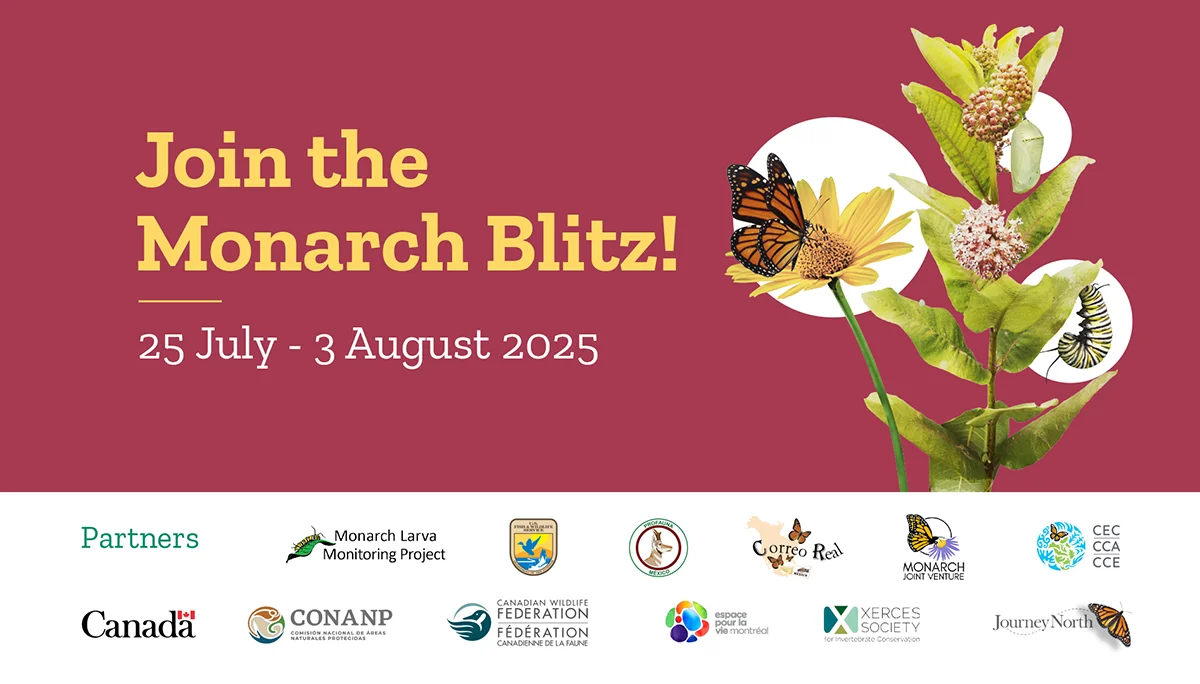Small Actions, Big Impact: Support Monarch Butterfly Conservation by Sharing Your Observations!

Join the 9th Edition of the International Monarch Monitoring Blitz, 25 July–3 August 2025!
Tiohtià:ke (Montreal), 9 July 2025 — The International Monarch Monitoring Blitz returns for its ninth edition from 25 July to 3 August 2025, inviting individuals and organizations across Canada, Mexico and the United States to come together in a unique cross-border effort to protect one of North America's most iconic species: the monarch butterfly.
Given the vast range of monarch butterflies and their host plant, milkweed, the contribution of volunteer community scientists is essential to furthering our understanding of these species and the habitats they depend on. In the face of climate change, both monarch butterflies and milkweed are expected to experience shifts in their distribution, underlining the urgent need for long-term data to track these changes and inform conservation strategies.
For 10 days, participants are encouraged to head outdoors to report sightings of monarch butterflies, locate milkweed plants and search for monarch eggs, caterpillars and chrysalises. Taking part is simple: just choose one of the participating community science programs and share your observations.
“The Monarch Joint Venture is proud to support the International Monarch Monitoring Blitz, a powerful example of international collaboration to better understand and protect one of North America's most iconic migratory species. Community science plays a vital role in tracking monarch populations and informing conservation action across borders—and every observation counts” — Wendy Caldwell, Executive Director, Monarch Joint Venture.
A Critical Moment for Conservation
The Monarch Blitz remains the only coordinated North America-wide effort to provide a real-time snapshot of the summer distribution of monarch butterflies in all its stages and of milkweed plants. This information is critical for tracking reproductive success and long-term population trends. The need is more pressing than ever: according to a recent survey conducted by WWF Mexico and Mexico’s National Commission of Protected Natural Areas (Conanp), the eastern migratory monarch population that overwinters in Mexico increased nearly twofold in 2025, expanding its occupied forest area to 4.42 acres, up from 2.22 acres in 2024. While this growth is encouraging, the figure remains well below the long-term average and highlights the continued urgency of efforts to conserve monarch breeding and migratory habitats.
“An increase in the area occupied by the monarch butterfly on its wintering grounds in Mexico during the 2024–2025 season gave us great joy this year; it provided impetus to step up our commitment to conserve this incredible migratory phenomenon. An important part of the conservation of this species is compiling information all along its migratory journey throughout the year. We are therefore inviting everyone in North America with an interest in the monarch butterfly to join the Monarch Blitz in 2025. In Mexico, the Blitz enables us to map out the local (non-migratory) monarch butterfly populations and to continue promoting their conservation,” said Jerónimo Chávez, Project Manager, Correo Real Program, Profauna A.C.
2024 Monarch Blitz Sets Participation Record
The eighth edition of the Blitz in 2024 saw record-breaking participation, with more than 5,000 people across the three countries reporting over 16,000 monarch sightings and 68,000 milkweed plants in just ten days.
These observations help identify priority areas for monarch conservation and guide concrete actions on the ground. All data collected during the Blitz will be made available through the Trinational Monarch Knowledge Network, hosted on GBIF, where it will support large-scale analyses by scientists, researchers and conservation practitioners.
“The Monarch Blitz is an example where community science (thanks to coordinated local action) can have a true continent-wide impact on the preservation of biodiversity. That collaboration, which brings together Canada, Mexico and the United States, embodies a real solution for implementing protective measures aimed at conserving the monarch butterfly” — Maxim Larrivée, Director, Insectarium de Montréal | Espace pour la vie.
With monarch conservation gaining momentum across North America, there has never been a better time for communities to get involved. Step outside, connect with nature and be part of the movement to protect the monarch butterfly!
Your Time to Shine!
To take part in the Monarch Blitz, please share your observations through one of the participating community science programs below:
- Canada:
- Mexico:
- United States:
Follow the Monarch Blitz and share your participation in this international conservation effort on social media by using the hashtag #MonarchBlitz!Organizations United for Monarch Conservation
The Blitz is organized by a collaboration of organizations from across North America, including the Commission for Environmental Cooperation (CEC), the Insectarium de Montréal | Espace pour la vie, Environment and Climate Change Canada (ECCC), the Canadian Wildlife Federation (CWF), the Monarch Joint Venture, Journey North, the U.S. Fish and Wildlife Service (USFWS), the Xerces Society for Invertebrate Conservation, Profauna A.C. and Mexico’s National Commission of Protected Natural Areas (Conanp).
Learn more about what we accomplished together last year and how you can get involved here on our website.
If you would like to know more about CEC initiatives, opportunities and efforts, you can sign up for our newsletter and follow us on social media.
